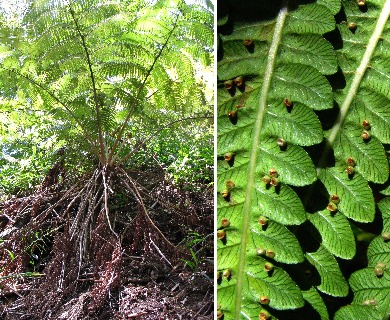Chamisso's Manfern
Cibotium chamissoi
Manfern family (Cibotiaceae)
Native species ()
This treefern is limited to wet forests of the island of Hawaii. It is recognized by the slender smooth trunk, by the leaf-stalks appearing hairless but covered with soft matted dull brown hairs with masses of pale, dull gray brown, narrow flattened hairlike on enlarged base and lower part; and by the leaf segments light green beneath.

©2010 David Eickhoff
Leaves () several, erect and spreading, the oldest dying and bending down along the trunk and breaking off cleanly, very large, feathery, divided 3 times (), mostly 5–6 ft (1.5–1.8 ) long. Leafstalk or axis () stout, flattened above, the enlarged base and lower part with masses of pale dull brown hairlike 1 1⁄4–2 inches (3–5 ), beyond green and hairless. The main axis bears many pairs of branches () to 2 1⁄2 ft (0. 8 ) long, further divided. Branches (pinnules) have many pairs, narrowly lance-shaped, 5–6 inches (13–15 ) long and 3⁄4 inch (2 ) wide, mostly with very short stalk at base, further divided or almost to Segments or many, nearly paired, oblong narrow rounded, to 3⁄8 inch (10 ) long and 3⁄16 inch (5 ) wide, with edges turned under and finely wavy, thin, upper surface light green with inconspicuous veins, lower surface dull light green with tiny cobwebby hairs.
Older leaf segments bear, on lower surface at ends of veins and on edges, two rows of seven or fewer yellowish boxlike cups (indusia) more than 1⁄32 inch (1 ) wide, each containing masses of dark brown cases (), which shed masses of microscopic abundantly.
The uses are similar to those described for the first species of treefern, but the stem is rarely large enough in diameter to be sawed or even bucked into “pots.”
Widespread in wet forests at low and middle altitudes; of 800–6000 ft (244–1829 ) on the Island of Hawaii. An understory plant in ‘ōhi‘a forests, often abundant in thickets.
Special area
Hawaii Volcanoes National Park, uncommon except in ‘Ōla‘a tract
Range
Island of Hawaii only
Other common name
hāpu‘u



